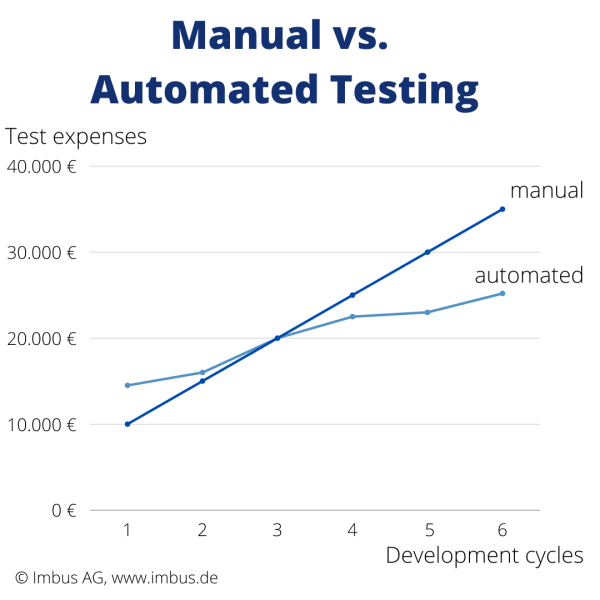With test automation (e.g. with QF-Test) after the third test cycle a positive balance can be reached already concerning test expenses. The individually reached ROI can vary of course.
In agile software development the ROI is reached faster due to shorter iteration cycles (daily at best) than in classical development and QA approaches.
The initial effort for automating tests is usually greater than doing manual tests.

Due to the consecutive development cycles more and more functionalities must be tested. The increasing test effort can just be handled with test automation.
In the course of time a great test base is created and for a maximum test coverage further tests are recorded bit by bit when there are new features.
Agile software development has lots of iterations and that's the reason why test automation is a necessity - in addition to unit tests and single manual tests.
| Time before automation | Time after automation | Savings | Citation |
|---|---|---|---|
| 8 hours | 1 hour | 87.5% | Thomas Schöning, ISTQB Certified Test Manager, Airbus Defence and Space GmbH, Multi-INT Products & Projects Germany: Running about 100 tests automatically and in parallel takes about one hour. Running the tests manually used to occupy one person for three hours per configuration. For the standard product and its configuration (two modes), this results in a saving of currently 8 hours per day, time which we happily invest in further automated tests or other activities. (see complete case study). |
| 8 weeks | 1 week | 87.5% | Sean Kane, Manager of Test Engineering, Intervoice Inc., Dallas, USA: But now we can regression test the application in 1 week. It used to take 8 weeks. |
| 2 weeks | 5 days | 50% | Gadi Goldbarg, Development Tools, QA Team Leader, Zend, Ramat Gan, Israel: The usage of QF-Test has reduced my test cycle from 2 weeks (plus/minus) to 5 days (since not all is automated yet). |
| 1 day | 3 hours | 62.5% | Denis Gauthier Software Integration, Thales Australia, Melbourne: Regarding the time saving aspect, it usually took me a full day to perform the Non-Regression Tests. It has now been reduced to three hours. (see complete case study). |
| 1 day | less than 1 hour | 87.5% | Phil Cross, Lockheed Martin, Owego New York, USA: Regression testing of our Java application that previously took a full day to execute is now done in less than an hour with QF-Test. |
| 7-8 hours | 1,5 hours | 80% | Heidi Klade, Logistik Pur Software GmbH, Koppl near Salzburg, Austria: Our tests run for about 90 minutes. I suppose that a manual test run would last about 7-8 hours of concentrated work. |
| Reduction of almost 50% | CertiCon, Prague, Czech Republic: In a matter of months we succeeded in reducing the test processing time by almost 50%, adding hundreds of additional test cases. (see complete case study). |
You can find the complete citations here: Advantages for decision-makers
The three pink phases of the test process (see image on the left) Test case development, test case execution and maintenance of test cases influence the return on investment (ROI) during the automation of tests the most.
| Phase of the test process | Manual Testing | Automated Testing |
|---|---|---|
| Test planning | Test planning includes the planning of the tests and the provision of the test environment. This is identical for manual and automated testing. | |
Test case specification | For manual and automated tests you need the analysis and description of the test cases. | |
| Development | In manual testing, you must elaborately create instructions for the testers that consistency can be maintained. | Implementing the test cases with the test tool takes time, money and resources. Therefore, the initial investment must be amortized over the test cycles. |
| Documentation | In manual testing, the test plan correlates with the test instructions. | Automated documentation can be generated quickly from the test cases. |
| Test case managment | With the manual or automated test strategy, documents must be managed in each case. | |
| Test execution | The test execution is the big cost driver here, namely hardware and personnel cause it. Careless errors are also possible. | The test tool is very reliable during test execution. It makes optimal use of the hardware. |
| Management of results | Manually, the results must be entered by hand. | Automated is the advantage the automatic report generation. This influences the quality of the report. |
| Maintenance of test cases | In manual testing, one would adjust the test instructions only after fundamental changes. | Of course, the test cases have to be adjusted in the GUI and this causes maintenance effort. However, the advantage of a test tool is that you only have to adjust them once in the graphical interface. In addition, modularization and a good recognition of the components is possible. |